Last Updated on May 27, 2023 by Ellen
With a few days to spare in Nepal’s capital before returning to India, I enjoyed playing tourist in Kathmandu. Husband Theo and I usually travel slower, but I’m glad we fit in this city before leaving Nepal.
One bizarre highlight was setting eyes on a “living goddess.”
Just as bizarre, but in a different way: alleyways filled with temples and buildings secured by heavy wooden beams so they don’t collapse. ‘Kathmandu’ means ‘made of wood’ or ‘wood pavilion’. The old town areas outside of the popular tourist zones are old, dusty, and filled with character. A photographer’s dream.
Other favorite places as a tourist in Kathmandu are a huge notable stupa, and the oldest Buddhist complex in Nepal. The latter offers incredible views of Kathmandu Valley, and both of these place have peaceful energy in a bustling city.
Playing tourist in Kathmandu
The Kumari
The ‘living goddess’ is the embodiment of Taleju (Durga) — as a young child. Nepali Buddhists and Hindus worship her. She is called The Kumari.
There is a selection process that identifies the girl when she is as young as three years old. Then she’s kept in the palace at the city’s Durbar Square until she menstruates, when she is then considered ‘unpure’ and returned to civilian life.
Twice a day she appears at a window in her palace to gaze upon devotees and curious tourists, like us. It was definitely bizarre! No pictures are allowed of The Kumari. But pictures are allowed of the courtyard where she appears in a third floor window.
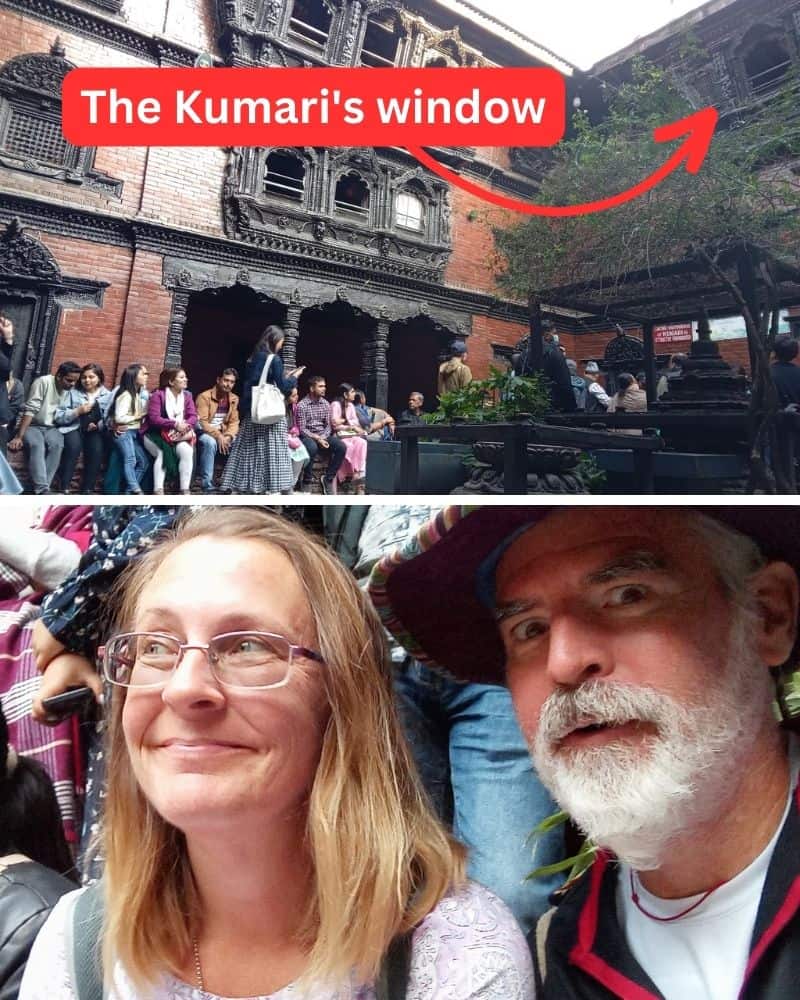
I won’t get into the criticisms here about how these little girls have been treated over the centuries, but if you are interested, read these outside sites for basic info about The Kumari, including an interview with a former ‘goddess’ who transitioned to mere mortal. (There are several Kumaris in Nepal, but the girl in Kathmandu is considered the ‘most important’.)
I’m just glad the little goddess didn’t laugh, cry, or rub her eyes while gazing out at us! Supposedly, that can mean imminent death or bad luck. And apparently, since we are among the few people on the planet to see her, we are considered to have good luck.
Tips to see the Kumari
There is no set time for her appearance – only two, two-hour windows each day. Luckily, we waited only 20 minutes, and had a great view of her. The courtyard is small. As we left, there were people waiting in the hallway to the courtyard – but they missed her brief appearance. It lasted only about 30 seconds.
Privileged Nepalis get to meet her in person. We saw a family from the crowd enter a courtyard door marked “Foreigners not allowed.” Shortly after their apparent visit with the Kumari in an unseen private room, she made her window appearance to us commoners.
Afraid of health care overseas? Don’t be!
Our special guide on global health care shows you:
- 7 easy steps to find the right doctors and hospitals
- Specific price examples for various medical services
- What to know about medical visas
- And more!
We go without travel health insurance, but many of the principles apply to those with coverage.
Durbar Square
All of this happens in The Kumari house in Durbar Square, which is part of the Kathmandu Valley UNESCO World Heritage site. It’s where kings once lived and ruled.
The architecture is unique, and reminded us a little of Cambodia, but instead of stone, much of it is wood and brick. Earthquakes over the years have caused major renovations at this site, and also the other sites further down in this post.
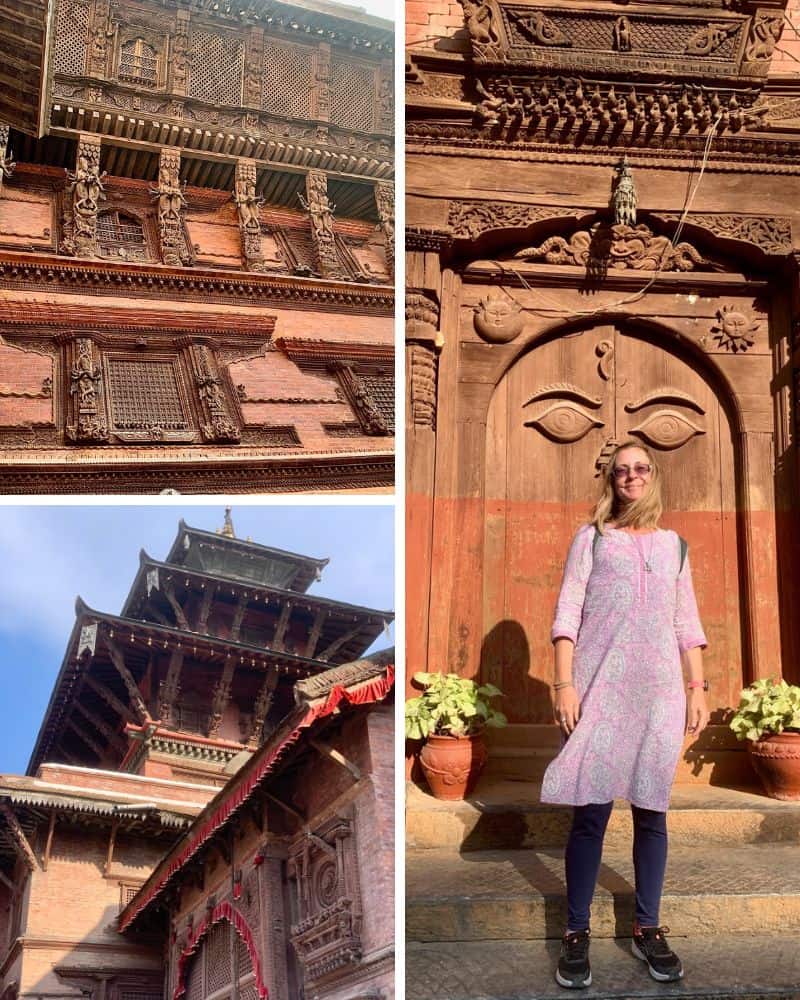
There is a museum on the grounds, but no pictures are allowed. The more interesting photography is outside on the grounds, anyway. Foreigners must pay 1,000 Nepalese rupees each ($7.50) to enter the square.
The architecture is amazing. We didn’t hire a guide. We simply used the map on the brochure that came with our entry fee.
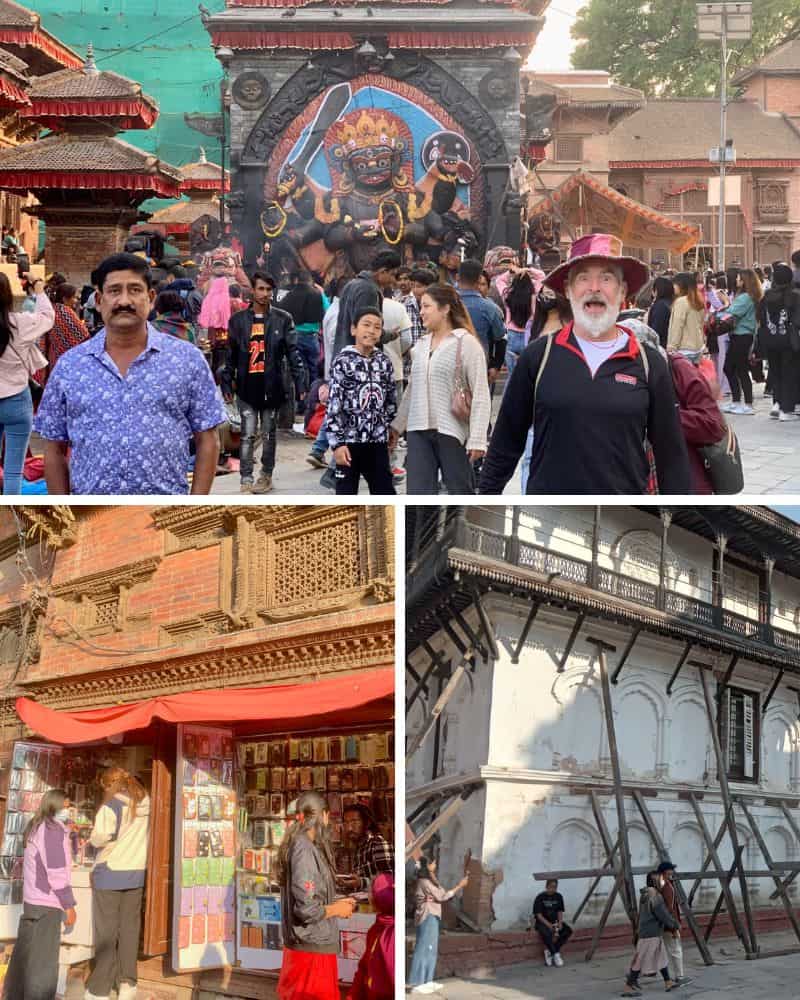
Like many other projects in Nepal, the Chinese have their hands on renovations in Durbar Square. I was not surprised, though surprisingly disappointed, when I saw the sign “China Aid for Shared Future.”
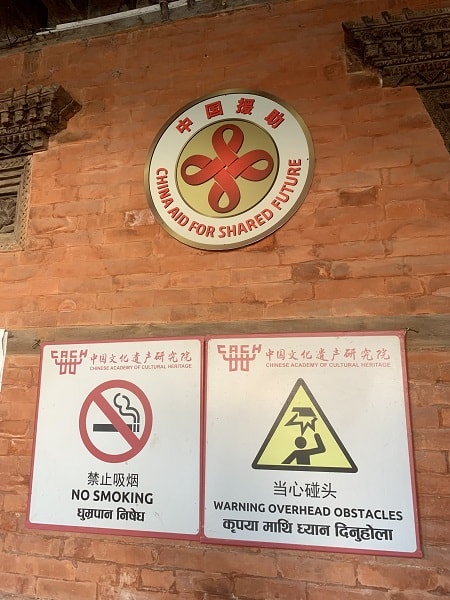
Hopefully, the contractors will do a better job here than on the roads from Butwal to Pokhara, and Pokhara to Kathmandu, which are so atrocious they are the worst we have ever seen on our world-wide travels.
Alleys, temples, shops
The popular part of Kathmandu for tourists is Thamel. But go beyond that to the area in between and around Thamel and Durbar Square and there are ancient alleys, temples, and interesting shops with bargain-basement prices. We bought a hat in a tiny store tucked into an alley for just $1.50.
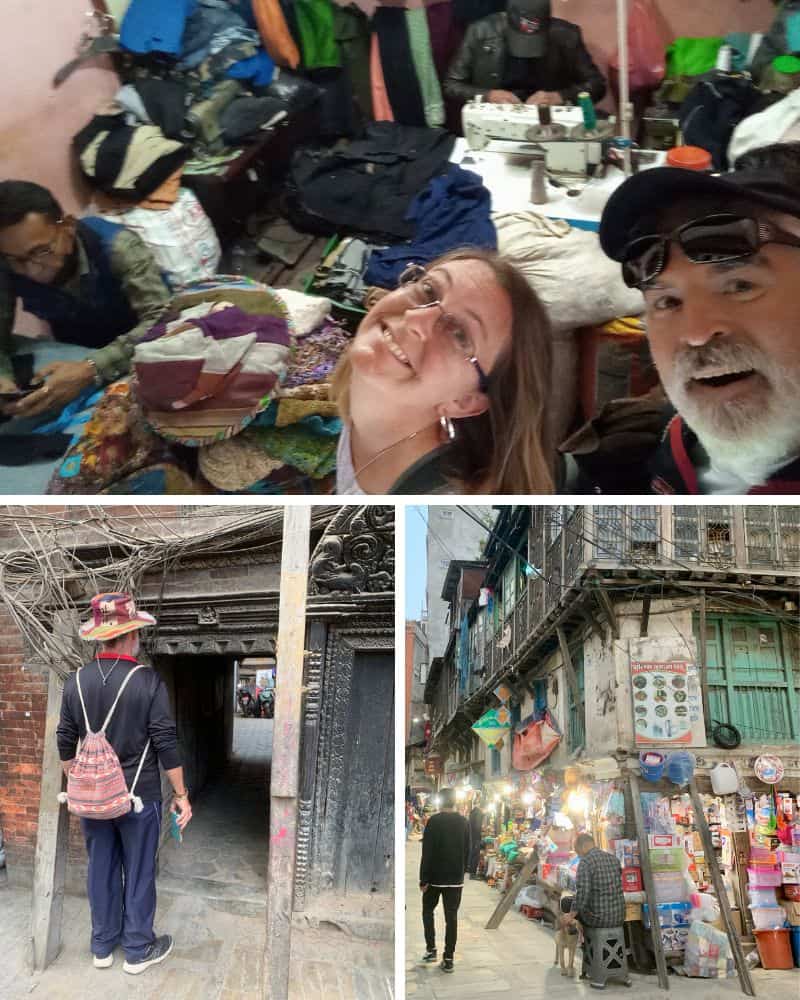
Temples and stupas seem to be around every corner. And once again, wooden beams help secure facades, and more.
The traffic in these areas is minimal compared to the main roads outside this old section, but still — be mindful of moto drivers while wandering and picture taking.
Bauddhanath (Boudhanath) Stupa
This is called the “Big Stupa” by locals. Admission is 400 rupees ($3) for foreigners. The “little stupa” is on the main road a short walk from the Bauddahanth/Boudhanath Stupa. Or more simply, The Buddha Stupa.
An information brochure comes with the price of admission, which is rare. It’s full of stories about the history of the site and its significance today. The claim is that The Buddha Stupa was built over the Buddha’s remains, but there are several other sites in Asia with the same claim.
Circumambulation is practiced at this stupa. People walk clockwise around the stupa as a tribute to Buddhist beliefs as they spin prayer wheels along the way. Most of the Buddhists are locals, but we also saw some foreigners, as well. We enjoyed walking around with them.

I also enjoyed a blessing by a Buddhist monk at Guru Lhakhang Gompa, one of four active Buddhist monasteries around the stupa. (Donations are appreciated.) I also was able to reach into a short meditation session as the monks chanted. Quite the experience! As I write this, Theo still is wearing the red string around his neck from his blessing.
Swayambhu/Swayambhunath complex
The Buddha Stupa and the Swayambhu/Swayambhunath complex are part of the Kathmandu Valley UNESCO World Heritage list. The Swayambhu site is in the center of the city on a large hill, so it offers fantastic views of Kathmandu.
Another photographer’s dream. My favorite picture from Kathmandu isn’t of the Himalayas. It’s of the silly husband:
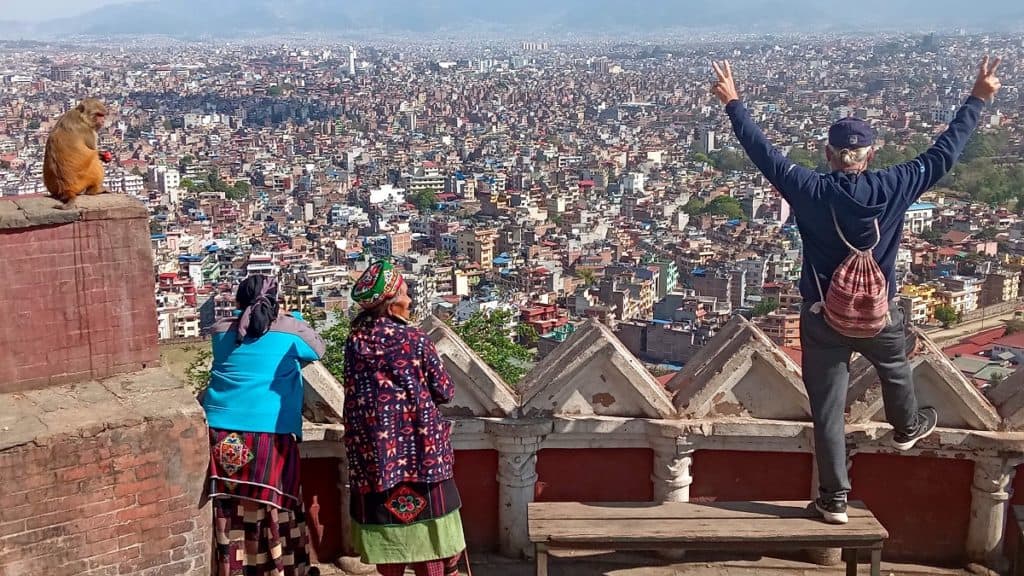
The Swayambhu complex is more of a tourist site because of its location and views. There are temples, bells, monuments, and a stupa. It’s crowded along the edges where people pose for photos.
The grounds are huge, however, and you can easily find a quiet shaded spot for contemplation. Just watch out for monkeys!
Admission for foreigners is 200 Nepalese rupees ($1.50).
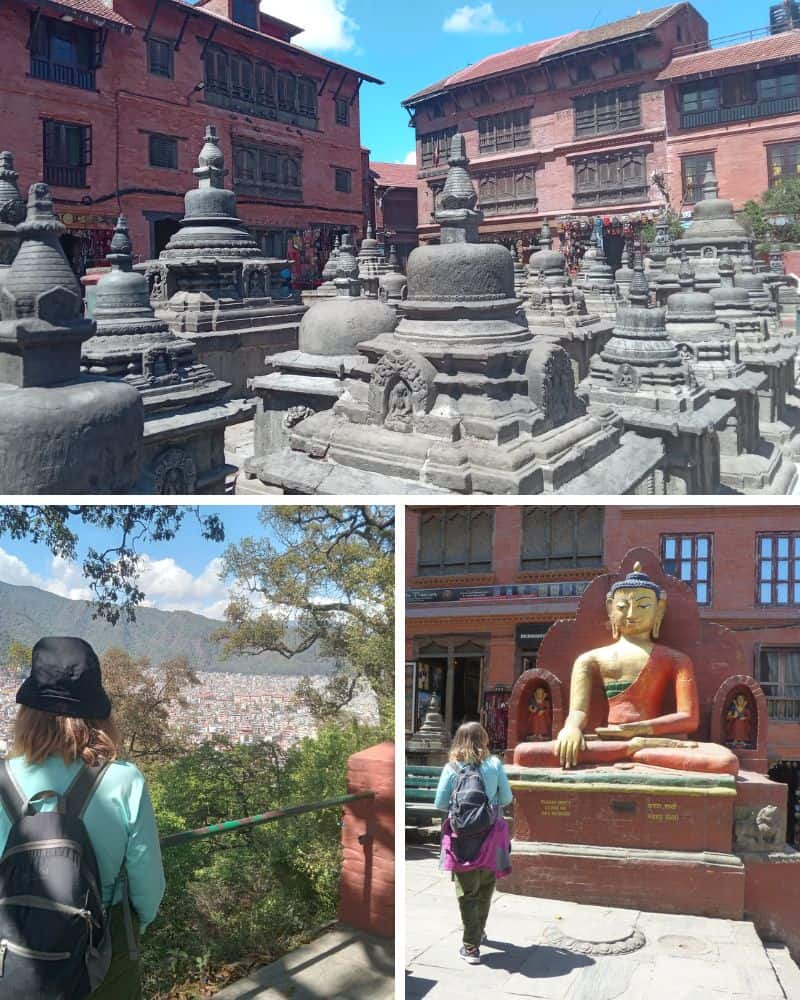
Tourists in Kathmandu
Another tourism draw — aside from trekking — is the cable car ride just to the west of Kathmandu Valley, which I previously wrote about. That is better done on a day or half-day trip, with an early morning arrival to the cable car station.
The cable car ride, and the activities listed above, made for five days filled with fun as we played tourist in Kathmandu. As slow travelers, we rarely stay for less than five days in one location, but for me, that felt about right for Kathmandu.
One stand out restaurant during our stay served ‘the best momos’ in the city. Stay tuned for Theo’s upcoming review.
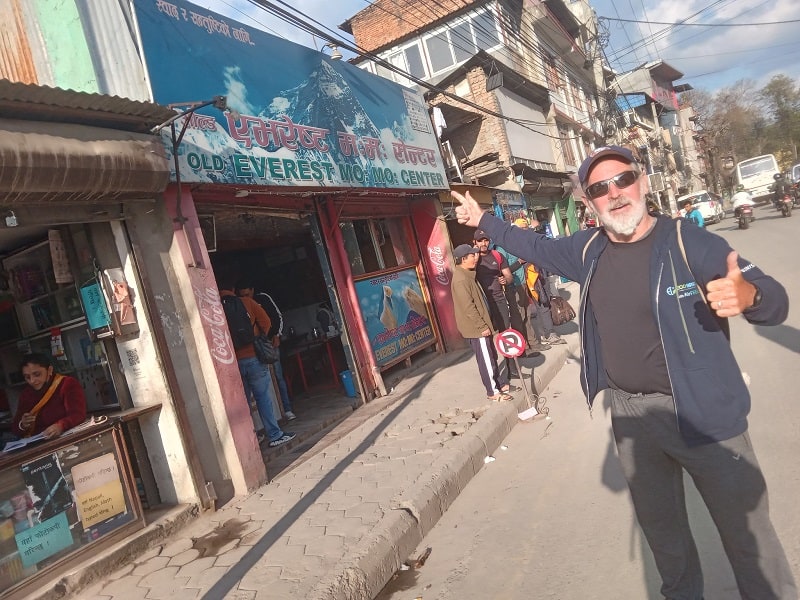
In the meantime, be generous and grateful — Life is Now!
